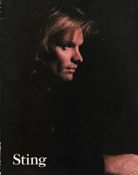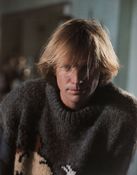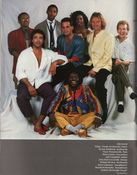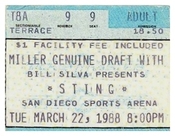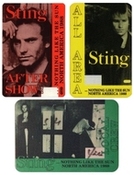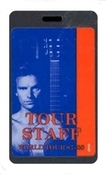
Nothing Like The Sun
Mar
22
1988
San Diego, CA, US
San Diego Sports Arena
Sting's the thing - his live show proves he was the force behind The Police...
He's no longer a Policeman, but Sting is still making some arresting music.
And what many music fans suspected all along during the Police's nearly 10-year reign - that Sting (Gordon Sumner) was the driving force behind the group's reggae-flavored pop and progressive rock 'n' roll - has been borne out. He has two successful solo albums, and the respect, however grudging, of both pop and jazz peers.
Sting went solo in 1985 (on the heels of the Police's most successful album to date, the brooding and powerful 'Synchronicity'). He left guitarist Andy Summers and drummer Stewart Copeland adrift amid a sea of Police reunion rumors and, since then, the 36-year-old British singer/songwriter has been an industry unto himself.
Sting and his 8-piece band will be in concert at 8 p.m. Tuesday at Memorial Coliseum.
In addition to his quirky and jazzy solo debut, 'The Dream of the Blue Turtles', the live follow-up, 'Bring On the Night', and his most recent double album, '...Nothing Like the Sun', Sting has also earned a solid reputation as an actor.
While he may not always have been as judicious in his choice of roles - 'Brimstone and Treacle', 'Dune' and 'The Bride' were roundly panned - roles in 'Julia and Julia' (with Kathleen Turner), and the upcoming 'Stormy Monday' have added ballast to a somewhat listing ship. No one can deny his intensity on the screen.
What also cannot be denied is his growth as both a songwriter and a band leader.
Both these strengths were displayed in abundance during his concert Tuesday night at the San Diego Sports Arena.
Combining reggae, pop, rock, jazz and acoustic resurrections of old Police tunes, Sting dazzled a surprisingly youthful crowd with his musicianship.
Backed by a band that includes Branford Marsalis on saxophone, Kenny Kirkland on keyboards and Mino Cinelu on percussion, Sting used the full-bodied pop and jazz tunes from '...Nothing Like the Sun' as a centerpiece.
Although his early recorded attempts at combining jazz riffs and changes with pop melodies were somewhat awkward, songs such as the atmospheric 'Be Still My Beating Heart' and the keening vocal power of 'The Lazarus Heart' are given a stretched-out treatment in a live setting.
Both songs have the kind of lyrical bite that characterized Sting's contribution to the Police: intelligence with the spark of reality that can only come from experience.
It's a wonder he has been able to maintain his current grueling tour schedule, what with the upcoming release of several albums on his own Pangaea label, and another round of Amnesty International benefit concerts with Peter Gabriel this summer. In addition, both his parents died last year.
Not only has he maintained the schedule (several dates on his North American tour were postponed when he developed a throat infection), he seems committed to giving his fans more than the standard 90-minute set. His San Diego show clocked in at three hours, with one 20-minute break.
Skeptics may scoff at what has been perceived as his pretentiouness, but it is hard to find fault with such musical gems as the somber yet hopeful 'They Dance Alone', a song dedicated to the women of Chile whose only means of protesting mass disappearances is to dance silently in the streets. Or the cooing, urban ambience of 'An Englishman in New York'.
Crack performances from Marsalis (playing both tenor and soprano saxophone) and guitarist Jeffrey Campbell gave both 'Rock Steady' and Jimi Hendrix's 'Little Wing' an intensity that is only hinted at on '...Nothing Like the Sun'.
Police tunes - 'King of Pain', 'When the World is Running Down (You Make the Best of What's Still Around)' and 'One World Is Enough', also benefited from weird time signatures and tempo changes.
But what really came across, above and beyond his celebrated star quality and suspected arrogance, was his sense of honesty and humanity.
In a world of false sincerity and self-centered leaders, Sting the man emerges as more than just another pop star.
(c) The Oregonian by Stuart Tomlinson
Sting steps boldly - concert braves uncharted territory...
Don't get me wrong. Sting's show last night at the Sports Arena was tops.
It won't soon be forgotten. But the image that will outlast this night occurred months ago and thousands of miles away.
It was during the final concert of his South American tour, last October in Buenos Aires, Argentina. As Sting sang the haunting 'They Dance Alone', the mothers, wives and children of the disappeared walked solemnly onto the stage and, standing behind Sting, they joined hands and raised them to the heavens.
Last night the film of that stirring moment flashed on a giant screen as Sting recited the Spanish verse of the song: Ellas danzan con los desaparecidos; Ellas danzan con los muertos... The faces of the women cried out far louder than the thousands in the audience, far louder than the music coming from the stage. These were faces so painfully incongruous at a pop concert, faces with eyes that spoke of immense sorrow. Faces wrapped in simple scarves, women present yet far removed from what is happening around them. Children slightly awed but more perplexed by what has become of their brothers, sisters, fathers.
The presence of these women - even on film - renders music and concerts frivolous, inconsequential. For they dance to a music heard only in their hearts and, one hopes, in the dark consciences of those who took their husbands, sons and children.
When Sting's Argentine concert ended, they returned to the plazas. There they still dance, silently, alone - a mute protest that demands answers, accountability. The music at the end of 'They Dance Alone' turns upbeat, optimistic, perhaps hopeful. It is a striking, powerful song, but no match for the images of those women.
This union of song and image was a particularly poignant moment, but it was merely the loftiest of a memorable night. Far from an exorcism of his Police days, Sting's solo career embraces the past while stepping boldly into uncharted territory. What is amazing is that his fans seem to have kept pace.
Earlier works like 'Don't Stand So Close to Me', 'If You Love Somebody Set Them Free', 'Roxanne', and especially 'King of Pain' drew instant recognition. But material from 'Dream of the Blue Turtles' and '...Nothing Like the Sun' was eagerly welcomed.
A good thing, too. Since nearly all of the 'Sun' album is incorporated in the two and a half hour concert. It could have been a long night if the audience weren't so receptive. But then, Sting is such a casual god on stage. He emits a relaxed charm that belies the show's tautness. He shakes a few hands, accepts bouquets from admirers and puts on the fool a bit, but the show runs on a stopwatch.
The show was essentially the same as that seen in San Antonio, Texas, a week ago with one significant exception: video. This show wasn't merely projected to the giant screen for the benefit of the folks in the distant back of the house. With some sophisticated equipment, the screen became an additional performer, sometimes overshadowing the action on stage. With two hand-held cameras and two mounted cameras, plus dissolves, split screens, overlapping images, multiple images, hip clips, time-twisted freeze-frames, paint-by-number colorization and whatever, the concert became an instantaneous extension of MTV. The dazzling video effects and up-close-and-personal shots even rivalled some of the stuff that creeps onto MTV these days.
The cameras caught everything: Mino Cinelu's frenzied percussive magic, Branford Marsalis' concentrated intensity on the saxophone, Kenny Kirkland's studied thoughtfulness at the keyboard, Jeff Campbell's stunning guitar solo on 'Little Wing', bassist Tracy Wormworth's demure smile, the passion of vocalist Dolette McDonald.
And Sting. The camera was never far from him, nor was the spotlight ever off him - even when others were taking solos. If there was an irritant of the evening, this was it. During 'Murder by Numbers' Sting stalked Marsalis with a bouquet of roses held knife-like as the saxophonist played.
As Kirkland soloed on 'Sister Moon' Sting climbed to the top of the tumble of cubes that served as a backdrop and danced alone. During 'Rock Steady' Sting crept up behind Marsalis and aped his style while blowing into his thumb.
Once or twice it's precious, but it grows tiresome quickly. Kirkland and Marsalis are performers of stature in the jazz world. Maybe they don't have the personal flair that pop music demands, but their music does. They deserve some dignity during their sojourn in Sting's pop palace.
Don't get me wrong. Sting appreciates his mates. Who else introduces his band during the opening number and lets each take a brief introductory solo? Their talents are not downplayed. Just observe the enchanting harmonic bridge Marsalis constructed between 'Englishman in New York' and 'Sister Moon'.
The first is Sting's pleasantly quirky tribute to the homosexual Quentin Crisp and to the courage of individuality. ''Be yourself no matter what they say,'' sings Sting, quietly fading as Marsalis, alone, lifts the moment with his sax. His stark, solo notes smoothly descend, taking with them the airiness of 'Englishman'.
Without breaking, Marsalis lifts the mood skyward again with the opening bars to 'Sister Moon', a slice of the blues that shades closely to the feel of Harlem Nocturne. Bekins couldn't pull off a move that smoothly.
Mino Cinelu's percussive layering of sounds from chimes, triangles, drums, bongos and timbals provided exquisite detail in the broadly drawn picture 'Be Still My Beating Heart'. The participation of musicians gradually diminished until Sting was chanting the title in cadence a capella. Until the stage went dark.
If 'Beating Heart' shifted from complexity to simplicity, the next song, 'Fragile' - a tribute to U.S. Ben Linder, killed by the Contras in 1987 - soared on simplicity alone. Sting accompanied himself on his Chet Atkins-signature Gibson guitar while Cinelu kept the beat on a simple earthen jug. The tender song ended with a single note and slap of the jug, eloquent in its starkness.
With only a moment's space, Sting began fingering notes that metamorphosed briefly into Jimi Hendrix's 'Voodoo Child' before taking flight as another Hendrix tune, 'Little Wing'.
Keyboardist Delmore Brown and guitarist Jeff Campbell both came to the fore on this with stunning solos. Brown matched his fingerings with high-pitched scat, note for note. Campbell obliterated all with two powerful solos.
Sting added his own dimension by inserting lyrics from a couple of John Lennon compositions. His mind was undoubtedly on a third fallen hero. The night before, jazz pianist-arranger Gil Evans had died. Even though 'Little Wing' is performed on the album with Evans' orchestra, Sting dedicated the last song of the first set, 'Bring On the Night' to Evans. Perhaps he did not wish to disrupt the delicately crafted moments that surround 'Little Wing' in concert.
As Sting raced through the next song, 'Home on the Range', the outstretched hands of a young woman were inches from his body, barely restrained by the burly guard who intercepted her lunge onto the stage.
For encores Sting opted for simplicity and intimacy with his audience. On 'The Secret Marriage' he was accompanied only by Kirkland's keyboard, Wormworth's bass and his own guitar. He had the last solo, on 'Message in a Bottle'. But the song was generously shared with the audience.
(c) The San Diego Union-Tribune by Robert J Hawkins
He's no longer a Policeman, but Sting is still making some arresting music.
And what many music fans suspected all along during the Police's nearly 10-year reign - that Sting (Gordon Sumner) was the driving force behind the group's reggae-flavored pop and progressive rock 'n' roll - has been borne out. He has two successful solo albums, and the respect, however grudging, of both pop and jazz peers.
Sting went solo in 1985 (on the heels of the Police's most successful album to date, the brooding and powerful 'Synchronicity'). He left guitarist Andy Summers and drummer Stewart Copeland adrift amid a sea of Police reunion rumors and, since then, the 36-year-old British singer/songwriter has been an industry unto himself.
Sting and his 8-piece band will be in concert at 8 p.m. Tuesday at Memorial Coliseum.
In addition to his quirky and jazzy solo debut, 'The Dream of the Blue Turtles', the live follow-up, 'Bring On the Night', and his most recent double album, '...Nothing Like the Sun', Sting has also earned a solid reputation as an actor.
While he may not always have been as judicious in his choice of roles - 'Brimstone and Treacle', 'Dune' and 'The Bride' were roundly panned - roles in 'Julia and Julia' (with Kathleen Turner), and the upcoming 'Stormy Monday' have added ballast to a somewhat listing ship. No one can deny his intensity on the screen.
What also cannot be denied is his growth as both a songwriter and a band leader.
Both these strengths were displayed in abundance during his concert Tuesday night at the San Diego Sports Arena.
Combining reggae, pop, rock, jazz and acoustic resurrections of old Police tunes, Sting dazzled a surprisingly youthful crowd with his musicianship.
Backed by a band that includes Branford Marsalis on saxophone, Kenny Kirkland on keyboards and Mino Cinelu on percussion, Sting used the full-bodied pop and jazz tunes from '...Nothing Like the Sun' as a centerpiece.
Although his early recorded attempts at combining jazz riffs and changes with pop melodies were somewhat awkward, songs such as the atmospheric 'Be Still My Beating Heart' and the keening vocal power of 'The Lazarus Heart' are given a stretched-out treatment in a live setting.
Both songs have the kind of lyrical bite that characterized Sting's contribution to the Police: intelligence with the spark of reality that can only come from experience.
It's a wonder he has been able to maintain his current grueling tour schedule, what with the upcoming release of several albums on his own Pangaea label, and another round of Amnesty International benefit concerts with Peter Gabriel this summer. In addition, both his parents died last year.
Not only has he maintained the schedule (several dates on his North American tour were postponed when he developed a throat infection), he seems committed to giving his fans more than the standard 90-minute set. His San Diego show clocked in at three hours, with one 20-minute break.
Skeptics may scoff at what has been perceived as his pretentiouness, but it is hard to find fault with such musical gems as the somber yet hopeful 'They Dance Alone', a song dedicated to the women of Chile whose only means of protesting mass disappearances is to dance silently in the streets. Or the cooing, urban ambience of 'An Englishman in New York'.
Crack performances from Marsalis (playing both tenor and soprano saxophone) and guitarist Jeffrey Campbell gave both 'Rock Steady' and Jimi Hendrix's 'Little Wing' an intensity that is only hinted at on '...Nothing Like the Sun'.
Police tunes - 'King of Pain', 'When the World is Running Down (You Make the Best of What's Still Around)' and 'One World Is Enough', also benefited from weird time signatures and tempo changes.
But what really came across, above and beyond his celebrated star quality and suspected arrogance, was his sense of honesty and humanity.
In a world of false sincerity and self-centered leaders, Sting the man emerges as more than just another pop star.
(c) The Oregonian by Stuart Tomlinson
Sting steps boldly - concert braves uncharted territory...
Don't get me wrong. Sting's show last night at the Sports Arena was tops.
It won't soon be forgotten. But the image that will outlast this night occurred months ago and thousands of miles away.
It was during the final concert of his South American tour, last October in Buenos Aires, Argentina. As Sting sang the haunting 'They Dance Alone', the mothers, wives and children of the disappeared walked solemnly onto the stage and, standing behind Sting, they joined hands and raised them to the heavens.
Last night the film of that stirring moment flashed on a giant screen as Sting recited the Spanish verse of the song: Ellas danzan con los desaparecidos; Ellas danzan con los muertos... The faces of the women cried out far louder than the thousands in the audience, far louder than the music coming from the stage. These were faces so painfully incongruous at a pop concert, faces with eyes that spoke of immense sorrow. Faces wrapped in simple scarves, women present yet far removed from what is happening around them. Children slightly awed but more perplexed by what has become of their brothers, sisters, fathers.
The presence of these women - even on film - renders music and concerts frivolous, inconsequential. For they dance to a music heard only in their hearts and, one hopes, in the dark consciences of those who took their husbands, sons and children.
When Sting's Argentine concert ended, they returned to the plazas. There they still dance, silently, alone - a mute protest that demands answers, accountability. The music at the end of 'They Dance Alone' turns upbeat, optimistic, perhaps hopeful. It is a striking, powerful song, but no match for the images of those women.
This union of song and image was a particularly poignant moment, but it was merely the loftiest of a memorable night. Far from an exorcism of his Police days, Sting's solo career embraces the past while stepping boldly into uncharted territory. What is amazing is that his fans seem to have kept pace.
Earlier works like 'Don't Stand So Close to Me', 'If You Love Somebody Set Them Free', 'Roxanne', and especially 'King of Pain' drew instant recognition. But material from 'Dream of the Blue Turtles' and '...Nothing Like the Sun' was eagerly welcomed.
A good thing, too. Since nearly all of the 'Sun' album is incorporated in the two and a half hour concert. It could have been a long night if the audience weren't so receptive. But then, Sting is such a casual god on stage. He emits a relaxed charm that belies the show's tautness. He shakes a few hands, accepts bouquets from admirers and puts on the fool a bit, but the show runs on a stopwatch.
The show was essentially the same as that seen in San Antonio, Texas, a week ago with one significant exception: video. This show wasn't merely projected to the giant screen for the benefit of the folks in the distant back of the house. With some sophisticated equipment, the screen became an additional performer, sometimes overshadowing the action on stage. With two hand-held cameras and two mounted cameras, plus dissolves, split screens, overlapping images, multiple images, hip clips, time-twisted freeze-frames, paint-by-number colorization and whatever, the concert became an instantaneous extension of MTV. The dazzling video effects and up-close-and-personal shots even rivalled some of the stuff that creeps onto MTV these days.
The cameras caught everything: Mino Cinelu's frenzied percussive magic, Branford Marsalis' concentrated intensity on the saxophone, Kenny Kirkland's studied thoughtfulness at the keyboard, Jeff Campbell's stunning guitar solo on 'Little Wing', bassist Tracy Wormworth's demure smile, the passion of vocalist Dolette McDonald.
And Sting. The camera was never far from him, nor was the spotlight ever off him - even when others were taking solos. If there was an irritant of the evening, this was it. During 'Murder by Numbers' Sting stalked Marsalis with a bouquet of roses held knife-like as the saxophonist played.
As Kirkland soloed on 'Sister Moon' Sting climbed to the top of the tumble of cubes that served as a backdrop and danced alone. During 'Rock Steady' Sting crept up behind Marsalis and aped his style while blowing into his thumb.
Once or twice it's precious, but it grows tiresome quickly. Kirkland and Marsalis are performers of stature in the jazz world. Maybe they don't have the personal flair that pop music demands, but their music does. They deserve some dignity during their sojourn in Sting's pop palace.
Don't get me wrong. Sting appreciates his mates. Who else introduces his band during the opening number and lets each take a brief introductory solo? Their talents are not downplayed. Just observe the enchanting harmonic bridge Marsalis constructed between 'Englishman in New York' and 'Sister Moon'.
The first is Sting's pleasantly quirky tribute to the homosexual Quentin Crisp and to the courage of individuality. ''Be yourself no matter what they say,'' sings Sting, quietly fading as Marsalis, alone, lifts the moment with his sax. His stark, solo notes smoothly descend, taking with them the airiness of 'Englishman'.
Without breaking, Marsalis lifts the mood skyward again with the opening bars to 'Sister Moon', a slice of the blues that shades closely to the feel of Harlem Nocturne. Bekins couldn't pull off a move that smoothly.
Mino Cinelu's percussive layering of sounds from chimes, triangles, drums, bongos and timbals provided exquisite detail in the broadly drawn picture 'Be Still My Beating Heart'. The participation of musicians gradually diminished until Sting was chanting the title in cadence a capella. Until the stage went dark.
If 'Beating Heart' shifted from complexity to simplicity, the next song, 'Fragile' - a tribute to U.S. Ben Linder, killed by the Contras in 1987 - soared on simplicity alone. Sting accompanied himself on his Chet Atkins-signature Gibson guitar while Cinelu kept the beat on a simple earthen jug. The tender song ended with a single note and slap of the jug, eloquent in its starkness.
With only a moment's space, Sting began fingering notes that metamorphosed briefly into Jimi Hendrix's 'Voodoo Child' before taking flight as another Hendrix tune, 'Little Wing'.
Keyboardist Delmore Brown and guitarist Jeff Campbell both came to the fore on this with stunning solos. Brown matched his fingerings with high-pitched scat, note for note. Campbell obliterated all with two powerful solos.
Sting added his own dimension by inserting lyrics from a couple of John Lennon compositions. His mind was undoubtedly on a third fallen hero. The night before, jazz pianist-arranger Gil Evans had died. Even though 'Little Wing' is performed on the album with Evans' orchestra, Sting dedicated the last song of the first set, 'Bring On the Night' to Evans. Perhaps he did not wish to disrupt the delicately crafted moments that surround 'Little Wing' in concert.
As Sting raced through the next song, 'Home on the Range', the outstretched hands of a young woman were inches from his body, barely restrained by the burly guard who intercepted her lunge onto the stage.
For encores Sting opted for simplicity and intimacy with his audience. On 'The Secret Marriage' he was accompanied only by Kirkland's keyboard, Wormworth's bass and his own guitar. He had the last solo, on 'Message in a Bottle'. But the song was generously shared with the audience.
(c) The San Diego Union-Tribune by Robert J Hawkins


